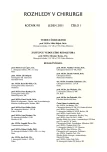Robot-Assisted Vascular Reconstructions in the Aortoiliac Region
Authors:
M. Dvořák; T. Novotný; R. Staffa
Authors‘ workplace:
Centrum robotické chirurgie FN u sv. Anny v Brně
; II. chirurgická klinika LF MU a FN u sv. Anny v Brně, přednosta: prof. MUDr. Robert Staffa, Ph. D.
Published in:
Rozhl. Chir., 2011, roč. 90, č. 1, s. 42-45.
Category:
Monothematic special - Original
Overview
Objectives:
The objective of the study was to evaluate the results of the robot-assisted laparoscopic aortoiliofemoral reconstructions in a group of 45 patients.
Materials and Methods:
The procedure is performed using three surgical techniques – conventional for the dissection of the vessels in the groin and distal anastomosis creation; laparoscopic for the dissection of the abdominal aorta and robotic for the proximal anastomosis creation. Between May 2006 and May 2010 we operated on 45 patients (37 males, 8 females) at a mean age of 57 years for aortoiliac occlusive disease using robot-assisted laparoscopic approach. We assessed the perioperative and hospitalization data.
Results:
We created 21 aortobifemoral, 22 aortofemoral and 2 iliofemoral bypasses. The median time of the proximal anastomosis creation was 23 minutes (range 18 to 50 minutes), median clamping time was 60 minutes (range 40 to 95 minutes), median total operating time was 295 minutes (range 180 to 475 minutes). The median estimated blood loss was 265 ml (range 50 to 1200 ml). The median ICU stay was 2 days (range 1 to 8 days). During the follow-up period (median 19 months; range 2 to 50 months), we observed 3 early occlusions (6.7%) – all due to an insufficient outflow. All occlusions were resolved by the extension of reconstructions. No renal, cardiac or pulmonary complications were observed. The 30-day mortality was 0%. Late complications: port-site hernia (2.2%). The secondary patency was 100%.
Conclusions:
The da Vinci robotic system allows a precise vascular anastomosis creation and blood loss minimization. The achieved results (clamping time, anastomosis time) are fully comparable to conventional vascular surgery. The robotic system eliminates the technical limitations of laparoscopic aortic anastomosis creation. Robot-assisted laparoscopic aortoiliofemoral bypass grafting seems a safe method with a low complication rate.
Key words:
da Vinci robotic system – laparoscopy – robot-assisted laparoscopic aortofemoral bypass
Sources
1. Dion, Y. M., Katkhouda, N., Rouleau, C., Aucoin, A. Laparoscopic-assisted aortobifemoral bypass. Surg. Laparosc. Endosc., 1993; 3 : 425–429.
2. Ruurda, J. P., Wisselink, W., Cuesta, M. A., Verhagen, H. J., Broeders, I. A. Robot-assisted versus standard videoscopic aortic replacement. A comparative study in pigs. Eur. J. Vasc. Endovasc. Surg., 2004; 27 : 501–506.
3. Wisselink, W., Cuesta, M. A., Gracia, C., Rauwerda, J. A. Robot-assisted laparoscopic Aortobifemoral bypass for aortoiliac occlusive disease: A report of two cases. J. Vasc. Surg., 2002; 36 : 1079–1082.
4. Mehrabi, A., Yetimoglu, C. L., Nickkholgh, A., Kashfi, A., Kienle, P., Konstantinides, L., Ahmadi, M. R., Fonouni, H., Schemmer, P., Friess, H., Gebhard, M. M., Buchler, M. W., Schmidt, J., Gutt, C. N. Development and evaluation of a training module for the clinical introduction of the da Vinci robotic system in visceral and vascular surgery. Surg. Endosc., 2006; 20 : 1376–1382. Epub 2006 Jul 20.
5. Dormandy, J. A., Rutherford, R. B. Management of peripheral arterial disease (PAD). TASC Working Group. TransAtlantic Inter-Society Consensus (TASC). J. Vasc. Surg., 2000; 31: S1–S296.
6. Norgren, L., Hiatt, W. R., Dormandy, J. A., Nehler, M. R., Harris, K. A., Fowkes, F. G. TASC II Working Group. Inter-Society Consensus for the Management of Peripheral Arterial Disease (TASC II). J. Vasc. Surg. 2007; 45 Suppl. S: S5–67.
7. Coggia, M., Bourriez, A., Javerliat, I., GoĎau-Brissonni
8. Štádler, P., Šebesta, P., Vitásek, P., Matouš, P., El Samman, K. A modified technique of transperitoneal direct approach for totally laparoscopic aortoiliac surgery. Eur. J. Vasc. Endovasc. Surg. 2006; 32 : 266–269.
9. Diks, J., Nio, D., Jongkind, V., Cuesta, M. A., Rauwerda, J. A., Wisselink, W. Robot-assisted laparoscopic surgery of the infrarenal aorta: the early learning curve. Surg. Endosc., 2007; 10 : 1760–1763.
10. Garrett, H. E. Jr., Fernandez, J. D., Porter, Ch. Robot-assisted laparoscopic aortobifemoral bypass: initial experience developing a new program. J. Robotic. Surg., 2008; 2 : 247–251.
11. Štádler, P., Dvořáček, L., Vitásek, P., Matouš, P. Is Robotic Surgery Appropriate for Vascular Procedures? Report of 100 Aortoiliac CASE. Eur. J. Vasc. Endovasc. Surg., 2008; 36 : 401–404.
12. Desgranges, P., Bourriez, A., Javerliat, I., Van Laere, O., Losy, F., Lobontiu, A. et al. Robotically assisted aorto-femoral bypass grafting: lessons learned from our initial experience. Eur. J. Vasc. Endovasc. Surg., 2004; 27 : 507–511.
Labels
Surgery Orthopaedics Trauma surgeryArticle was published in
Perspectives in Surgery

2011 Issue 1
- Metamizole vs. Tramadol in Postoperative Analgesia
- Obstacle Called Vasospasm: Which Solution Is Most Effective in Microsurgery and How to Pharmacologically Assist It?
- Current Insights into the Antispasmodic and Analgesic Effects of Metamizole on the Gastrointestinal Tract
- Spasmolytic Effect of Metamizole
Most read in this issue
- Splenic Artery Aneurysm as a Cause of Abdominal Pain and Hypotension
- Current Trends in the Surgical Management of Thoracoabdominal Aortic Aneurysms
- Cytostatic Hyperthermic Isolated Limb Perfusion (HILP) in VFN (General Faculty Hospital in Prague)
- Radical Operation of Infected Aortofemoral Prosthesis using Fresh Arterial Allograft: Our Mid-term Experience
